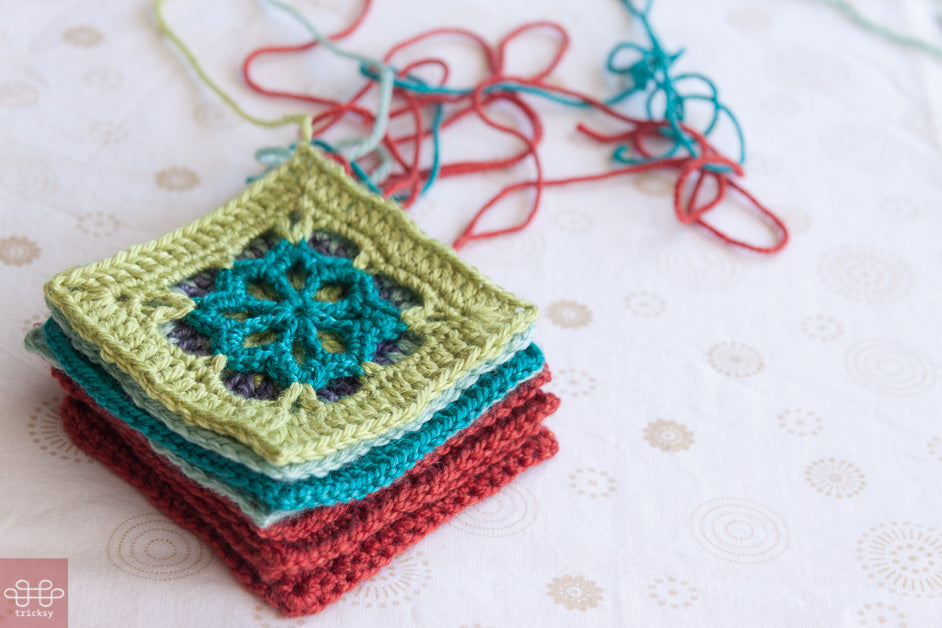- I like it that it's new and I don't know much about it. There's no pressure to be expert at it, turn it into a pattern, write a book about it, etc. Whenever I knit something, I'm always concerned with the project's viability as a blog post, a pattern, or a tutorial. I rarely get to knit for pleasure.
- I enjoy the charming kitsch of crochet. Although it can be sophisticated, crochet seems to be at its best when it's simple, cheerful and unpretentious. I love it on bedspreads and pillows and pincushions.
- It's incredibly modular. Every stitch of crochet is self-contained in a way, since a crochet stitch is much like a bound/cast off stitch in knitting. And it's quite acceptable, even expected, to work in blocks and then piece them together. This is a nice way to work, a piece here, a piece there. It's also a really liberating way to work with colour. It's like getting your big box of coloured pencils out and doodling. Knitting with colour is rarely so carefree any more (see first bullet point).
- Crochet charts are things of beauty! I'm a big fan of charts (no kidding right? why else would I ask Charles to make me an online chartmaker?) and knitting charts are wonderfully logical. But knitting tends to move in a strict two dimensional plane, with limited options. Of course there are exceptions, like short rows and sophisticated motifs. But crochet moves wherever you want, and can move up and be three-dimensional. Yes, I know, knitting can do that too, but not easily; compare the amount of work-turning required to make a simple knitted bobble to the ease with which you can add a crocheted flower and you'll see my point. Anyways, back to the charts. A crochet chart is like a very good map in a universal language. I have some Japanese knitting books, and they include a few crochet patterns. I've always ignored the crochet charts because I didn't understand the symbols. But now, with my new crochet eyes, I'm starting to see that they are not only a coded representation of a repeated pattern, but also an illustration of each stitch and its position in the fabric.
More random thoughts:
My first forays into crochet are squares. "Granny squares" but I have taken against the terminology. It relegates the whole thing to feminine and elderly. There is obviously nothing wrong with being feminine and/or elderly, but the implication is that these things are trivial and wimpy. I'm going to call them... "G-Squares". There, now the implications are G-man, gangsta or G-spot, although I suppose all those things could also be elderly and feminine, one shouldn't assume otherwise.
I like the traditional G-square because most of the time you get to crochet into a space instead of a stitch. This would also make it a good learning project for kids. Here's one of my first crocheted squares. Simple, traditional, one-colour (in Madelinetosh Pashmina colour Byzantine). The geometric simplicity of the traditional square is lovely, and I think a good complement to variegated yarn.

Here's another traditional crocheted G-square, but in lace weight this time, and three colours. I like the contrast of using luxury yarn for something normally done in a chunkier weight (from the inside colour out: Americal Original Sedoso, Sweatermaker Yarns Fiona, and Madelinetosh Tosh Lace. Sorry, I don't know the colour names offhand). I think that's one of the appealing things about Sophie Digard scarves: the contrast of rustic-looking stitches with complex colour palettes in very fine yarn.

And a G-square can be much more than the traditional geometric block. It's really anything that can be crocheted and squared off. Let's see, what yarn is this in the next image... left Shibui Staccato; middle Shibui Staccato and Mirasol Nuna; right Mirasol Nuna and a tiny bit of SweetGeorgia CashLuxe Fine for the violet ring. These ones are (with minor adaptations and mistakes) from an ibook I bought on the iPad, More Than a Granny by Shelley Husband (left to right, Solid Stella (with 4 extra holes added when I had an epiphany about how to make holes), Dawnie, and Auntie Dot. There are a lot of G-square books available, but I like the 20 squares in this collection. And Shelley Husband has a free, beginner Granny Square Crochet for Beginners ebook as well. It's step-by-step, which is nice.


If you're into crochet, I'm keeping a pinterest board of crochet. I love the delicate Japanese crocheted fern, it's amazing work.

"
